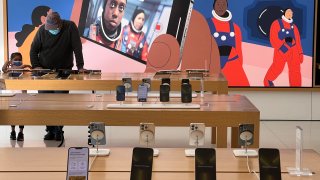
- Annual smartphone shipment grew 4% year on year to 1.39 billion handsets in 2021 even as the pandemic and a worldwide chip shortage hampered supplies, according to Counterpoint Research.
- The market research firm's data showed that in 2017, smartphone makers shipped 1.56 billion units and that figure subsequently declined every year from 2018 to 2020.
- Samsung held on to the pole position as the world's largest smartphone maker by shipment volume despite its Vietnam factories being under a Covid lockdown for some time.
The global smartphone market grew for the first time in four years — but the total number of devices shipped last year remained below the pre-pandemic level, according to a report from market research firm Counterpart Research.
Annual smartphone shipment grew 4% year on year to 1.39 billion handsets in 2021 even as the Covid pandemic and a worldwide components shortage hampered supplies.
Counterpoint data showed that in 2017, smartphone makers shipped 1.56 billion units and that figure subsequently declined every year from 2018 to 2020.
Feeling out of the loop? We'll catch you up on the Chicago news you need to know. Sign up for the weekly Chicago Catch-Up newsletter here.
Pent-up demand in places like North America, Latin America and India contributed to the market's overall growth last year, according to Harmeet Singh Walia, senior analyst at Counterpoint Research.
"Growth in the US was driven largely by demand for Apple's first 5G-enabled iPhone 12 series seeping through to the first quarter of 2021," Walia said in a statement. That demand continued throughout the year as the October-December quarter ended on a strong note because of holiday promotions and Black Friday sales, he added.
Money Report
India saw higher replacement rates for devices, better availability as well as more attractive financing options for the mid- to high-end phones, Singh Walia said.
Counterpoint Research this week said that smartphone sales in China fell 2% year on year for several reasons, including the global semiconductor and component shortages that hindered the ability for smartphone makers to ship their devices.
"The market recovery could have been even better if not for the component shortages that impacted much of the second half of 2021. The major brands navigated the component shortages comparatively better and hence managed to grow by gaining share from long-tail brands," Singh Walia said.
How did the top smartphone makers do?
Samsung held on to the pole position as the world's largest smartphone maker by shipment volume despite its Vietnam factories being under a Covid lockdown for some time.
The South Korean company shipped about 271 million devices in 2021, which accounted for a 6% year-on-year growth as demand for its mid-tier phones increased.
Samsung this week said it expects demand for smartphones and tablets in the current quarter to decline from the October-December period due to weak seasonality and uncertainties over component supply. But the company said it plans to expand sales of its flagship Galaxy S series devices and roll out competitive, mass-market 5G handsets.
Counterpoint noted that some of Samsung's growth was limited by growing competition in markets like India and Latin America.
Apple, which reported record-high market share in China last quarter, saw its global smartphone shipments grow by 18% year on year to 237.9 million units because of the strong performance of the iPhone 12 series. Its shipment volume grew in key markets like the United States, China, Europe and India.
"In China, it became the top smartphone brand in Q4 after six years thanks to the iPhone 13, consequently overtaking Samsung as the top smartphone globally in Q4 2021," Counterpoint Research said in its report.
Chinese smartphone maker Xiaomi saw its global shipment grow by 31% year on year to 190 million devices. Though its shipment volume was significantly behind that of Samsung and Apple, Xiaomi has grown in recent years to become the third-largest smartphone maker in the world.
In fact, it's now the top smartphone brand in India after dethroning Samsung in 2018.
Oppo and Vivo also registered double-digit growths last year, shipping 143.2 million and 131.3 million devices, respectively.
Counterpoint Research said in its report that there's reason to be optimistic for the smartphone industry's growth prospects in 2022 if the world gets a handle on the pandemic and if supply chain shortages are resolved by the middle of the year.
Some analysts and investors, however, expect the global chip shortage to last till end of this year or well into 2023.






